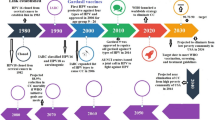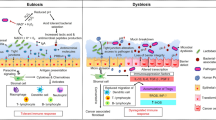Abstract
The aim of this study was to understand the association of human papillomavirus (HPV) type 16/18 infection and polymorphisms in the HLA-DQB1 (rs6457617) and IL-1β –511 (rs16944) loci with the development of uterine cervical cancer (CaCx). The distribution of HLA-DQB1 G > A and IL-1β −511 C/T polymorphisms was determined in HPV-negative cervical swabs from normal women (N = 111) and compared with cervical swabs of HPV-cleared normal women (once HPV infected followed by natural clearance of the infection, N = 86), HPV16/18-positive cervical intraepithelial neoplasia (CIN, N = 41) and CaCx biopsies (N = 107). The A-allele containing genotypes (i.e. G/A and A/A) of HLA-DQB1 was significantly associated with CaCx compared with HPV-negative [OR = 2.56(1.42–4.62), p = 0.001] or HPV-cleared [OR = 2.07(1.12–3.87), p = 0.01] normal women, whereas the T-allele containing genotypes (i.e. C/T and T/T) of IL-1β showed increased risk of CIN [OR = 3.68(0.97–16.35), p = 0.03; OR = 3.59(0.92–16.38), p = 0.03] and CaCx development [OR = 2.03(1.03–5.2), p = 0.02; OR = 2.25(0.96–5.31), p = 0.04] compared with HPV-negative or HPV-cleared normal women. Considering these two loci together, it was evident that the T- and A-alleles rendered significantly increased susceptibility for development of CIN and CaCx compared with HPV-negative and HPV-cleared normal women. Moreover, the T-allele of IL-1β showed increased susceptibility for CIN [OR = 3.62(0.85–17.95), p = 0.04] and CaCx [OR = 2.39(0.91–6.37), p = 0.05] development compared with the HPV-cleared women, even in the presence of the HLA-DQB1 G-allele. Thus, our data suggest that persistent HPV16/18 infection in the cervix due to the presence of the HLA-DQB1 A-allele and chronic inflammation due to the presence of the IL-1β –511 T-allele might predispose women to CaCx development.


Similar content being viewed by others
Abbreviations
- AGUS:
-
Atypical glandular cells of undetermined significance
- ASCUS:
-
Atypical squamous cells of undetermined significance
- CaCx:
-
Uterine cervical cancer
- CI:
-
Confidence interval
- CIN:
-
Cervical intraepithelial neoplasia
- HLA:
-
Human leucocyte antigen
- HPV:
-
Human papillomavirus
- IL:
-
Interleukin
- LCR:
-
Long control region
- LD:
-
Linkage disequilibrium
- MHC:
-
Major histocompatibility complex
- OR:
-
Odds ratio
- PCR:
-
Polymerase chain reaction
- RFLP:
-
Restriction fragment length polymorphism
- SD:
-
Standard deviation
- TCR:
-
T cell receptors
References
Ferlay J, Shin HR, Bray F, Forman D, Mathers C, Parkin DM (2010) Estimates of worldwide burden of cancer in 2008: GLOBOCAN 2008. Int J Cancer 127:2893–2917
Walboomers JM, Jacobs MV, Manos MM, Bosch FX, Kummer JA, Shah KV, Snijders PJ, Peto J, Meijer CJ, Munoz N (1999) Human papillomavirus is a necessary cause of invasive cervical cancer worldwide. J Pathol 189:12–19
Bruni L, Barrionuevo-Rosas L, Serrano B, Brotons M, Cosano R, Muñoz J, Bosch FX, de Sanjosé S, Castellsagué X (2014) ICO Information Centre on HPV and Cancer (HPV Information Centre). Human Papillomavirus and Related Diseases in India. Summary Report 2014-03-17. http://www.hpvcentre.net/statistics/reports/XWX.pdf. Accessed 18 Dec 2014
Snijders PJ, Steenbergen RD, Heideman DA, Meijer CJ (2006) HPV-mediated cervical carcinogenesis: concepts and clinical implications. J Pathol 208:152–164
Gough SC, Simmonds MJ (2007) The HLA region and autoimmune disease: associations and mechanisms of action. Curr Genomics 8:453–465
Beck S, Inoko DGH, Rowen L (1999) Complete sequence and gene map of a human major histocompatibility complex. The MHC sequencing consortium. Nature 401:921–923
Tindle RW (2002) Immune evasion in human papillomavirus-associated cervical cancer. Nat Rev Cancer 2:59–65
Moss DJ, Khanna R (1999) Major histocompatibility complex: from genes to function. Immunol Today 20:165–167
Mueller LP, Machulla HK (2002) Increased frequency of homozygosity for HLA class II loci in female patients with chronic lymphocytic leukemia. Leuk Lymphoma 43:1013–1019
Thursz MR, Thomas HC, Greenwood BM, Hill AV (1997) Heterozygote advantage for HLA class-II type in hepatitis B virus infection. Nat Genet 17:11–12
Wank R, Thomssen C (1991) High risk of squamous cell carcinoma of the cervix for women with HLA-DQw3. Nature 352:723–725
Helland A, Borresen AL, Kristensen G, Ronningen KS (1994) DQA1 and DQB1 genes in patients with squamous cell carcinoma of the cervix: relationship to human papillomavirus infection and prognosis. Cancer Epidemiol Biomarkers Prev 3:479–486
Nawa A, Nishiyama Y, Kobayashi T, Wakahara Y, Okamoto T, Kikkawa F, Suganuma N, Goto S, Kuzuya K, Tomoda Y (1995) Association of human leukocyte antigen-B1*03 with cervical cancer in Japanese women aged 35 years and younger. Cancer 75:518–521
Bird S, Zou J, Wang T, Munday B, Cunningham C, Secombes CJ (2002) Evolution of interleukin-1beta. Cytokine Growth Factor Rev 13:483–502
Sobti RC, Kordi Tamandani DM, Shekari M, Kaur P, Malekzadeh K, Suri V (2008) Interleukin 1 beta gene polymorphism and risk of cervical cancer. Int J Gynaecol Obstet 101:47–52
Hall SK, Perregaux DG, Gabel CA, Woodworth T, Durham LK, Huizinga TW, Breedveld FC, Seymour AB (2004) Correlation of polymorphic variation in the promoter region of the interleukin-1 beta gene with secretion of interleukin-1 beta protein. Arthritis Rheum 50:1976–1983
Chen H, Wilkins LM, Aziz N, Cannings C, Wyllie DH, Bingle C, Rogus J, Beck JD, Offenbacher S, Cork MJ, Rafie-Kolpin M, Hsieh CM, Kornman KS, Duff GW (2006) Single nucleotide polymorphisms in the human interleukin-1B gene affect transcription according to haplotype context. Hum Mol Genet 15:519–529
Al-Tahhan MA, Etewa RL, El Behery MM (2011) Association between circulating interleukin-1 beta (IL-1beta) levels and IL-1beta C-511T polymorphism with cervical cancer risk in Egyptian women. Mol Cell Biochem 353:159–165
Basu P, Dutta S, Begum R, Mittal S, Dutta PD, Bharti AC, Panda CK, Biswas J, Dey B, Talwar GP, Das BC (2013) Clearance of cervical human papillomavirus infection by topical application of curcumin and curcumin containing polyherbal cream: a phase II randomized controlled study. Asian Pac J Cancer Prev 14:5753–5759
Dutta S, Begum R, Mazumder Indra D, Mandal SS, Mondal R, Biswas J, Dey B, Panda CK, Basu P (2012) Prevalence of human papillomavirus in women without cervical cancer: a population-based study in Eastern India. Int J Gynecol Pathol 31:178–183
Sambrook J, Fritsch EF, Maniatis T (1989) Molecular cloning: a laboratory manual, 2nd edn. Cold Spring Harbor Press, New York
Chakrabarti S, Dasgupta S, Roy S, Bhar A, Sengupta A, Roy A, Ray K, Bhattacharyya NP, Roy B, Panda CK, Roychoudhury S (2001) Microsatellite instability in squamous cell carcinoma of head and neck from the Indian patient population. Int J Cancer 92:555–561
Mehal WZ, Lo Y-MD, Herrington CS, Evans MF, Papadopoulos MC, Odunsi K, Ganesan TS, McGee JO’D, Bell JI, Fleming KA (1994) Role of human papillomavirus in determining the HLA associated risk of cervical carcinogenesis. J Clin Pathol 47:1077–1081
Allanore Y, Saad M, Dieudé P, Avouac J, Distler JH, Amouyel P, Matucci-Cerinic M et al (2011) Genome-wide scan identifies TNIP1, PSORS1C1, and RHOB as novel risk loci for systemic sclerosis. PLoS Genet 7(7):e1002091
Bhattacharya P, Sengupta S (2007) Predisposition to HPV16/18-related cervical cancer because of proline homozygosity at codon 72 of p53 among Indian women is influenced by HLA-B*07 and homozygosity of HLA-DQB1*03. Tissue Antigens 70:283–293
Liu J, Zhai X, Jin G, Hu Z, Wang S, Wang X, Qin J, Gao J, Ma H, Wang X, Wei Q, Shen H (2006) Functional variants in the promoter of interleukin-1beta are associated with an increased risk of breast cancer: a case-control analysis in a Chinese population. Int J Cancer 118:2554–2558
Montoya L, Saiz I, Rey G, Vela F, Clerici-Larradet N (1998) Cervical carcinoma: human papillomavirus infection and HLA-associated risk factors in the Spanish population. Eur J Immunogenet 25:329–337
Gregoire L, Lawrence WD, Kukuruga D, Eisenbrey AB, Lancaster WD (1994) Association between HLA-DQB1 alleles and risk for cervical cancer in African-American women. Int J Cancer 57:504–507
Glew SS, Stern PL, Davidson JA, Dyer PA (1992) HLA antigens and cervical carcinoma. Nature 356:22
Glew SS, Duggan-Keen M, Ghosh AK, Ivinson A, Sinnott P, Davidson J, Dyer PA, Stern PL (1993) Lack of association of HLA polymorphisms with human papillomavirus-related cervical cancer. Hum Immunol 37:157–164
Allen M, Kalantari M, Ylitalo N, Pettersson B, Hagmar B, Scheibenpflug L, Johansson B, Petterson U, Gyllensten U (1996) HLA DQ-DR haplotype and susceptibility to cervical carcinoma: indications of increased risk for development of cervical carcinoma in individuals infected with HPV 18. Tissue Antigens 48:32–37
Apple RJ, Erlich HA, Klitz W, Manos MM, Becker TM, Wheeler CM (1994) HLA DR-DQ associations with cervical carcinoma show papillomavirus-type specificity. Nat Genet 6:157–162
Maciag PC, Schlecht NF, Souza PS, Rohan TE, Franco EL, Villa LL (2002) Polymorphisms of the human leukocyte antigen DRB1 and DQB1 genes and the natural history of human papillomavirus infection. J Infect Dis 186:164–172
El-Omar EM, Carrington M, Chow WH, McColl KE, Bream JH, Young HA, Herrera J, Lissowska J, Yuan CC, Rothman N, Lanyon G, Martin M, Fraumeni JF Jr, Rabkin CS (2000) Interleukin-1 polymorphisms associated with increased risk of gastric cancer. Nature 404:398–402
Lee KA, Ki CS, Kim HJ, Sohn KM, Kim JW, Kang WK, Rhee JC, Song SY, Sohn TS (2004) Novel interleukin 1beta polymorphism increased the risk of gastric cancer in a Korean population. J Gastroenterol 39:429–433
Zienolddiny S, Ryberg D, Maggini V, Skaug V, Canzian F, Haugen A (2004) Polymorphisms of the interleukin-1 beta gene are associated with increased risk of non-small cell lung cancer. Int J Cancer 109:353–356
Hirankarn N, Kimkong I, Kummee P, Tangkijvanich P, Poovorawan Y (2006) Interleukin-1beta gene polymorphism associated with hepatocellular carcinoma in hepatitis B virus infection. World J Gastroenterol 12:776–779
Kang S, Kim JW, Park NH, Song YS, Park SY, Kang SB, Lee HP (2007) Interleukin-1 beta-511 polymorphism and risk of cervical cancer. J Korean Med Sci 22:110–113
Singh H, Sachan R, Goel H, Mittal B (2008) Genetic variants of interleukin-1RN and interleukin-1beta genes and risk of cervical cancer. BJOG 115:633–638
Bamba H, Ota S, Kato A, Matsuzaki F (1998) Nonsteroidal antiinflammatory drugs may delay the repair of gastric mucosa by suppressing prostaglandin-mediated increase of hepatocyte growth factor production. Biochem Biophys Res Commun 245:567–571
Roshak AK, Jackson JR, McGough K, Chabot-Fletcher M, Mochan E, Marshall LA (1996) Manipulation of distinct NF kappaB proteins alters interleukin-1beta-induced human rheumatoid synovial fibroblast prostaglandin E2 formation. J Biol Chem 271:31496–31501
Rahman MA, Dhar DK, Yamaguchi E, Maruyama S, Sato T, Hayashi H, Ono T, Yamanoi A, Kohno H, Nagasue N (2001) Coexpression of inducible nitric oxide synthase and COX-2 in hepatocellular carcinoma and surrounding liver: possible involvement of COX-2 in the angiogenesis of hepatitis C virus positive cases. Clin Cancer Res 7:1325–1332
Donaldson P, Agarwal K, Craggs A, Craig W, James O, Jones D (2001) HLA and interleukin 1 gene polymorphisms in primary biliary cirrhosis: associations with disease progression and disease susceptibility. Gut 48:397–402
Acknowledgments
We extend our gratitude to Professors H. zur Hausen and E. M. de Villiers for their generous gifts of HPV16 and HPV18 plasmids. Financial supports for this work were provided by Senior Research Fellowship Grants from Council of Scientific & Industrial Research (CSIR), Government of India, to S. Dutta [File No. 09/030(0065)/2011-EMR-I] and C. Chakraborty [File No. 09/030(0059)/2010-EMR-I] and Extramural grant from the Department of Science and Technology (DST), Government of India [SR/SO/HS-116/2007 of dt. 07/09/2011], to Dr. C. K. Panda and Dr S Roychoudhury.
Conflict of interest
The authors declare that there are no conflicts of interest with regard to the work presented in this article.
Author information
Authors and Affiliations
Corresponding author
Electronic supplementary material
Below is the link to the electronic supplementary material.
Rights and permissions
About this article
Cite this article
Dutta, S., Chakraborty, C., Mandal, R.K. et al. Persistent HPV16/18 infection in Indian women with the A-allele (rs6457617) of HLA-DQB1 and T-allele (rs16944) of IL-1β −511 is associated with development of cervical carcinoma. Cancer Immunol Immunother 64, 843–851 (2015). https://doi.org/10.1007/s00262-015-1693-5
Received:
Accepted:
Published:
Issue Date:
DOI: https://doi.org/10.1007/s00262-015-1693-5




